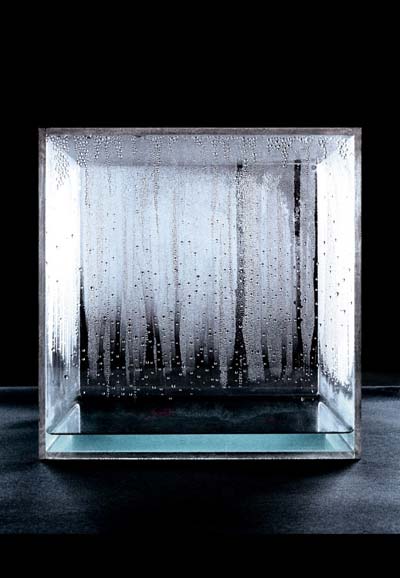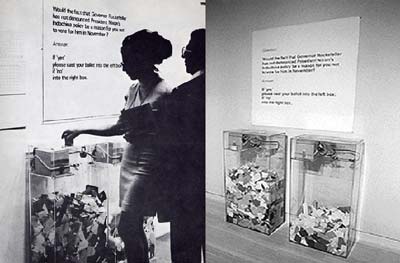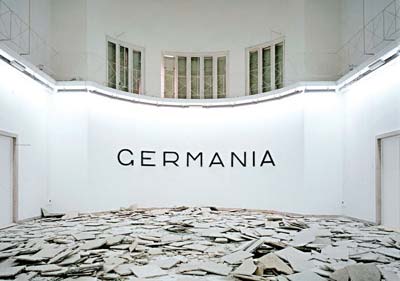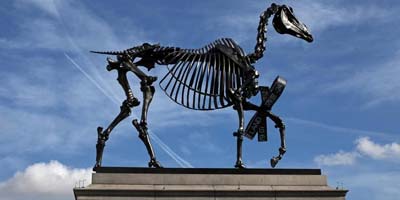Written by Brazina Maria, MBA in Contemporary Art Sales, Display and Collecting
BRAZINA Maria. Hans Haacke: Exploring Systems
In 1971, Guggenheim Museum in New York abruptly canceled Hans Haacke’s solo show, saying that politics does not belong inside the museum. Naturally, the erupted scandal only helped to promote Haacke’s art. Since then, Haacke became a politically engaged artist par excellence and he remains a highly ‘uncomfortable’ artist, as he usually focuses his art on the contemporary socio-political issues. His usually anti glamorous, yet in a way spectacular, social experiments on a relevant contemporary issues consider the society as a complex socio-political and economic system, which represents a “dog-eat-dog” world with the museums being one of the main targets of his critique. For over 40 years Haacke remains devoted to a rigorous and uncompromising ideals of the early institutional critique, which can be linked to the documental aesthetics of the American conceptualism. Haacke develops the ideas of conceptualism by using the language and poetics of conceptual art not only to speak about art in itself but also to speak about political issues. His artistic language evolves around the contemporary socio-political issues, inviting visitors to contribute to the creation of an artwork and to question the system of contemporary society.
Natural system
Hans Haacke was born in 1936 in Cologne (Germany) and his artistic career has started in the end of 1950s with the abstract paintings. However, it didn’t last long and, after moving to New York in the 1960s, Haacke started to create sculptures from natural elements: water, steam, light, wind, and ice. Works from that period are the closed eco-systems which have become the living organisms. They are created from the simplest elements but at the same time they are constantly changing and evolving, following the complex rules of nature and interacting with the surrounding environment. These early works can be conceived as closed microclimates as Haacke was creating works that are constantly changing and reacting on the environment, resulting in being unpredictable in their never-finished form. Notion of a system becomes crucial in Haacke’s art: works of art are not as important in itself but are important in interaction with other elements, including the visitors, who are also an integral part of the system.
In the beginning of his career Haacke was interested in the biological and physical processes that happen in the nature. One of the most representative and famous works from this period is Condensation Cube (Kondensationwürfel), 1963-65.
[IMAGE: Hans Haacke, Condensation Cube, 1965. Plexiglass and water, 76x76x76cm]

The installation is made out of plexiglass and water. Light and temperature are the integral parts of work as the surrounding environment has an influence on the physical condensation processes that happen inside of the cube. In a transparent, hermetic, plexiglass cube there is a couple of centimeters of water. The bright light is directed on the cube. Gradually, under the bright exhibition lights the temperature inside of the cube rises and becomes higher than the temperature outside in the exhibition space, therefore, the water starts to evaporate. Small drops of water start to gather and form the bigger drops; the bigger drops then form the flows, which start to drip down and move along the walls of the cube. These movement is forced by the unnoticeable changes of the air flows in the exhibition space, including the movement of the visitors. The processes that happen in the nature and their intercorrelations are the substantial components of the Haacke’s art piece and its surroundings. On the one hand, cube is an enclosed space with the physical contents (water, air, pressure and temperature). On the other, what is inside the cube is correlated with and influenced by what is happening outside in the surrounding environment. About the Condensation Cube Haacke wrote: “The process of condensation does not end. The box has a constantly but slowly changing appearance that never repeats itself. The conditions are comparable to those of a living organism that reacts in a flexible manner to its surroundings. The image of condensation cannot be precisely predicted. It is changing freely, bound only by statistical limits. I like this freedom.” [P.1]
Among other early works it is important to mention the Grass Grows, which was shown in the February of 1969 on the Earth Art exhibition at a Cornel University [P.2]. By the end of 1960s Haacke’s experiments with the natural elements and processes had reached the limits of deceptive simplicity. With the Condensation Cube (1963-65) he started with the two elements: water and air. In the Grass Grows (1969) he introduces a new element – the earth. The installation is comprised of a pile of soil with the grass seeds inside it, which start to grow during the time of an exhibition, transforming a pile of soil into a small green mountain. With the similar logic of an eco-system as in the Condensation Cube, this artwork can be also conceived as a land art piece, which is placed into an exhibition space. At the same time, it is also a natural developing and complex system, which constantly transforms as the time passes.
In 1965 Haacke wrote a manifesto, which perfectly combines the logic of his works of that period:
…make something which experiences, reacts to its environment, changes, is nonstable…
…make something indeterminate, that always looks different, the shape of which cannot be predicted precisely…
…make something that cannot “perform” without the assistance of its environment…
…make something sensitive to light and temperature changes, that is subject to air currents and depends, in its functioning, on the forces of gravity…
…make something the spectator handles, an object to be played with and thus animated…
…make something that lives in time and makes the “spectator” experience time…
…articulate something natural… [P.3]
Gradually Haacke started to be interested not only in the basic physical processes but also in a processes simultaneously predictable and unique – the processes happening in the animal world. In 1969 in the Chickens Hatching Haacke placed eight incubators with chicken eggs in the exhibition space, anticipating the results. In the same year, he created the Ant-Coop, where he was observing the establishment of the social relationships within the ant farm. In a sense, this was the starting point of Haacke’s further interest in complex human social systems.
Social system
By the end of 1960s Haacke started to gradually move away from the natural systems to the social ones. MoMA Poll installation was created for the Information exhibition, curated by Kynaston McShine in 1970 at the MoMA (New York) [P.4]. The exhibition featured artworks by international artists, which by the beginning of the 1970s started to transform art from the source of an abstract and unexplainable aesthetic pleasure to an information carrier. The exhibition was held at the MoMA where Nelson Rockefeller, a governor of New York city at the time, was a member of a board of trustees. Haacke has put a question on the wall, inviting the visitors to answer it by putting the ballots with ‘yes’ or ‘no’ answers into the dedicated transparent polling boxes, which resemble the plexiglass cube, used earlier in the Condensation Cube. The question, posed by the artist, asked visitors whether “the fact that Governor Rockefeller has not denounced President Nixon’s Indochina policy would be a reason for you [visitors] not to vote for him in November? [W.1]” By the end of the exhibition the ‘yes’-answers exceeded the ‘no’-answers by half. Being a real sociological questionnaire, MoMA Poll not only brought attention to the political issues of the time but also implied that visitors are essential part of an artwork, as their answers had formed it.
[IMAGE: Hans Haacke, MoMA Poll, installation, two plexiglass poll boxes, wall text. 1970]

Shapolsky et al. Manhattan Real Estate Holdings, A Real Time Social System, as of May 1, 1971 (1971) is an event which is may be considered as the most important in the Haacke’s artistic practice. In Shapolsky et al., which was prepared for the Haacke’s solo show at Guggenheim Museum (New York), the artist presented evidence of the 20 years of the Harry Shapolsky’s commercial activities. The form, that Haacke chose, was resembling more a documental journalistic investigation rather than an artwork in its traditional sense. Harry Shapolsky was an owner of a New York’s real estate agency and a friend and business partner of a couple of Guggenheim’s trustees. Haacke’s artwork included 146 photographs of the real estate on Manhattan, supported with the typescripts with data on the property (address, type of building, surface of the site, date of acquisition, owner or its cadastral value), an explanatory panel, and two plans of the “troubled” areas of New York. All of the documentation was proving the unlawful activities of Mr. Shapolsky. Later, his connection with the Guggenheim Museum was refuted. However, the museum decided to cancel the show six weeks before the opening. This incident has exposed the interrelation of social, political, and financial power and its leverage in the art world. This work, targeted to criticise the institutions, can be linked to the practices of the conceptual art – the use of language and pre-existing “objective” documentation are put in such perspective, where the concept, idea, and controversial political issue becomes more important that the “art object” that is present inside of the exhibition space.
Haacke came back to the sociological questionnaire of the visitors of the gallery as a form of conceptual art in 1972 in his Visitors’ Profile project for Documenta 5 (Kassel, Germany), curated by Harold Szeemann. In Kassel, Haacke created a visitors’ profile – a collective social portrait of visitors, who have filled in the socio-demographical questionnaire, proposed by the artist, where he was asking visitors to indicate their birthplace and place of living and indicate it on the map. Collected answers were analysed by the electronic data processing systems and were put up on the wall, forming a socio-demographic map. This project was a proper sociological study on the people who visit galleries and museums. Haacke has created the collective portrait of an audience; not an individual, but statistical. This installation is another prominent example of an artwork which would have been impossible without the active participation of the visitors, as their answers constructed the artwork, building upon the concept, proposed by the artist.
It is interesting how Haacke’s interests at the time were corresponding with the interests of one of the most prominent sociologists – Pierre Bourdieu. In the Distinction: A Social Critique of the Judgement of the Taste [P.5] Bourdieu describes how the segments of society, who have the economic and political power, create the notions of the “aesthetic taste”. Bourdieu was claiming that the interests and preferences of the person are usually determined by the social class. The difference between the social classes in a day-to-day life is established by the hierarchies, which are based on the inherent abilities to distinguish between good and bad, high and low. Obviously, when Haacke was asking the visitors of Documenta to share their sociological affiliation he was pointing that they were brought there not only by the coincidence or the highly-developed sense of sublime, but because of the mechanisms and interconnectivity within the complex social system.
Despite the rough path with the institutional critique and “uncomfortable” questions that Haacke was raising, his official recognition came in 1993, when he was awarded the “Golden Lion” for the German pavilion for the Venice Biennale. The pavilion was reconstructed in 1937 in honor to Adolf Hitler – the wooden floors were replaced with marble. For the installation Haacke has broken the marble floor of the pavilion in pieces, which were visually representing the numerous “harsh edges” of the German history and also creating a visual allusion to Caspar David Friedrich’s Sea of Ice (1824). Historical specificity was amplified with the photograph of Adolf Hitler visiting the Venice Biennale in 1934, a huge Deutschemark from 1990, and a repetition of a “Germania” inscription inside of the space. For a person, who speaks German (in German language the name of the country is Deutschland and not Germania) and knows the German history, it was a reminder of the Hitler’s monumental plans to reconstruct Berlin after the war and create a new mythical capital – Germania [W.2]. This installation is another example of the institutional critique and political approach of Haacke’s art, as he was questioning whether the German pavilion should be conceived as a piece of architecture or should be associated with the fascist heritage.
[IMAGE: Hans Haacke, Germania, installation, 1993 Venice Biennale, German pavilion ; Caspar David Friedrich, Sea of Ice, 1824. Oil on canvas, 96.7x126.9cm, Kunsthalle Hamburg, Germany]

Nowadays Haacke continues working with the ideas of socio-political activism. In 2015, on the Fourth Plinth on the Trafalgar Square in London the Gift Horse sculpture was installed. The bronze skeleton of the horse, with an attached live news ticker ribbon of the London Stock exchange to its leg, is an allusion to the term “invisible hand of the market”, introduced in 1766 by Adam Smith [W.3], and the Anatomy of the Horse [P.6] by George Stubbs, which was published in the same year. As the Germania project for the 1993 Venice Biennale was highlighting the dangers of politics appropriating the culture, similarly, the Haacke’s Trojan Gift Horse plays with the past as well as with the present, touching upon the contemporary world issues and criticizing the social classes and capitalism. Throughout his artistic career Hans Haacke has been sustaining a strong and engaged point of view on the contemporary society; and with his artworks he is inviting visitors to critically assess the world we are living in. His practice constantly shows that art is an integral part of the society and socio-political system. By emphasizing this correlation, Haacke points that art can make a difference and have an influence on the contemporary world issues with the same vigour with which socio-political system influences the art world.
[IMAGE: Hans Haacke, Gift Horse, 2014. Bronze, LED lights. Height 4.6m. Fourth Plinth, Trafalgar Square, London, UK]

References
[P.1] FLECK, Robert, FLUEGGE, Matthias. Hans Haacke: Wirklich Werke 1959-2006 [exhibition catalogue], 2007. 340 p.
[P.2] JAGER, Nita. Earth Art [exhibition catalogue]. Cornell University, 1969. 88 p.
[P.3] HAACKE, Hans. Cologne, January, 1965. Republished in Art in the Land. A Critical Anthology of Environmental Art, ed. by Alan Sonfist. New York: Dutton, 1983. 274 p.
[P.4] McSHINE, Kynaston L. Information [exhibition catalogue], Baltimore: Publication Press, 1970. 207 p.
[P.5] BOURDIEU, Pierre. Distinction: A Social Critique of the Judgement of Taste. Translated by R. Nice. Harvard University Press: Cambridge, Massachusetts, 1996. 613 p.
[P.6] STUBBS, George. The Anatomy of the Horse. Edited by J. A. Allen. London, 1965. (Originally published in 1766). 147 p.
BOURDIEU, Pierre, HAACKE, Hans. Free Exchange. Oxford: Polity Press, 1995. 144 p.
BUCHLOH, Benjamin H. D. Neo-Avantgarde and Culture Industry: Essays on European and American Art from 1955 to 1975. Cambridge, Massachusetts; London, England: MIT Press, 2003. P. 203-243.
BUSSMANN, Klaus, MATZNER, Florian. Hans Haacke, Bodenlos: Biennale Venedig 1993, Deutscher Pavillon. Berlin: Cantz, 1993. 137 p.
DANTO, Arthur C. The Wake of Art: Criticism, Philosophy, and the Ends of Taste. G+B Arts International, 1998. P. 129-137.
HAACKE, Hans, DEUTSCHE, Rosalyn, WALLIS, Brian. Hans Haacke: unfinished business. New York: The MIT Press, The New Museum of Contemporary Art, 1986. 303 p.
Online resources
[W.1] Information exhibition press release. The Museum of Modern Art, New York, 2 July, 1970. https://www.moma.org/documents/moma_press-release_326692.pdf
[W.2] http://www.spiegel.de/international/germany/insanity-on-the-spree-new-ex...
[W.3] SMITH Adam. Wealth of Nations. Edited by S. M. Soares. MetaLibri Digital Library, 2007. P. 349. https://www.ibiblio.org/ml/libri/s/SmithA_WealthNations_p.pdf
MORGAN, Tiernan. Hans Haacke on "Gift Horse," Gulf Labor, and Artist Resale Royalties. July 23, 2015. https://hyperallergic.com/213069/hans-haacke-on-gift-horse-gulf-labor-an... [Accessed 7 Apr. 2019].


 Download application form
Download application form